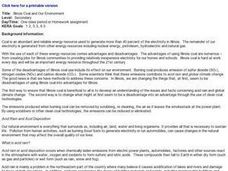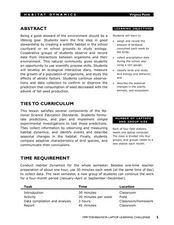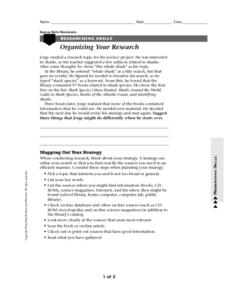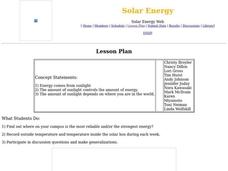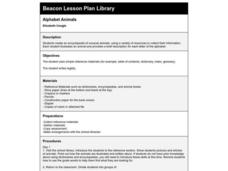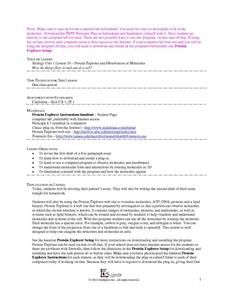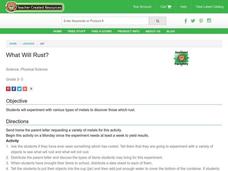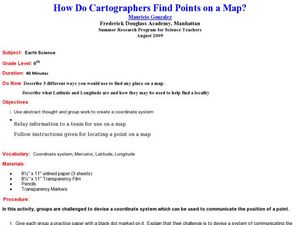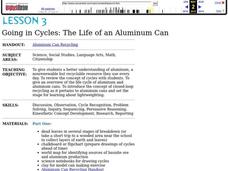Curated OER
Ramps 1: Let It Roll!
Students explore and measure the rate of spherical objects rolling down a ramp. They discuss why different ramps work better than others, and practice procedures for testing designs and recording results.
Curated OER
Our Water Resources
Students build a model aquifer to study groundwater zones and water table formation. Students use the models to measure the movement of polluted groundwater.
Curated OER
Reading the Waves
Students view video segments which reveal the parts of sound and what factors control sound. The viewing and post-viewing activities serve to reinforce the video segments using worksheets and hands-out experiments.
Curated OER
The Gifts of Trees
Students examine the various things trees give us. They read the book, "The Giving Tree" by Shel Silverstein, cook a food using a tree fruit, create notepads using unused paper, construct a picture frame with twigs, and write a poem.
Curated OER
An Interdisciplinary Deer and Human Population Study
Students answer the question, "What environmental problems arise due to animal and human overpopulation and what might need to be done to combat these problems?" They play games, graph data and write proposals about the question.
Curated OER
Kentucky Coal and Our Environment
Young scholars read and discuss the article in reference to the environmental issues of acid rain and global climate change in relation to Kentucky coal. They then answer questions that are related to the article that they read.
Curated OER
Illinois Coal and Our Environment
Students read and discuss the important environmental issues of acid rain and global climate change in relation to Illinois coal. According to the National Acid Precipitation Assessment Program, acid rain has had minimal effects on our...
Curated OER
THE FOODS WE EAT
Students discuss the five food groups and the seven basic nutrients. They decorate Food We Eat booklet pages with pictures of foods found on background, rubber stamp and animation tools in KidPix. (Booklet has a page for each food group.)
Curated OER
What Do You Know About the Birds Around You?
Students compare and contrast various species of birds. After participating in a brief discussion of the characteristics of birds, they view birds in their natural habitat and in pictures with a focus on the similarities and differences...
Curated OER
Habitat Dynamics
Students develop an interactive diary to record bird seed consumption. In this habitat instructional activity, students predict and record the amount of birdseed eaten each week by birds.
Curated OER
My Time
Students create a timeline of their lives. In this timeline lesson, students discuss relative and absolute time. They use events in their lives to create categories on a timeline. They link this lesson to geologic timelines.
Curated OER
Organizing your Research
In this research worksheet, students read about how to organize themselves when doing research. They read about a student who had a topic to research but had difficulty coming up with books about his topic. Students suggest ways to...
Curated OER
Solar Energy
Young scholars find out where on campus is the most reliable and/or the strongest energy, record outside temperature and temperature inside the solar box during each week, and participate in discussion questions and make generalizations.
Curated OER
Take A Meal Worm To Lunch
Seventh graders, using a magnifying glass, observe mealworms in a cup.
Curated OER
Alphabet Animals
Second graders create an encyclopedia of unusual animals, using a variety of resources to collect their information. Each student illustrates an animal and provides a brief description for each letter of the alphabet. A very nice,...
Curated OER
How do things flow in and out of a cell?
Students use a word processing program successfully. They are able to complete a final draft of a Lab Report and turn in all drafts for a formal letter grade. Students finish type their Lab Reports, they are reminded to use the spell...
Curated OER
What Will Rust?
Students discuss if they have ever seen anything that has rusted. They place metal objects into the cup and then add just enough water to cover the bottom of the container. They complete information on their data sheets and record as...
Curated OER
Problem-Solving Math 1
Students discuss the different ways we use numbers in everyday life. They walk around the classroom for 5 to 10 minutes, students are asked to point out examples of numbers they find in the room. Students are asked to image a world...
Curated OER
Bimaadagaako Adventure
Students use an interactive website to complete a wilderness trail adventure where they learn about Native cultures, voyagers, and the Canadian fur trade. In this interactive history lesson, students visit the wilderness classroom...
Curated OER
How Do Cartographers Find Points on a Map?
Ninth graders describe latitude and longitude and how they may be useful to find things on a map. In this cartography lesson students divide into groups and devise a coordinate system that can be used to communicate a position.
Curated OER
Scarecrow Recycled
Young scholars create their own scarecrows. In this recycling lesson, students discuss the purpose of scarecrows and discuss how they are constructed. Young scholars make their own scarecrows out of recycled materials.
Curated OER
Save the Bay!
Students explore environmental protection by creating a presentation in class. In this Chesapeake Bay lesson, students discuss the current threats from human beings towards the delicate balance of life near the bay. Students identify the...
Curated OER
History of the Battery
Students study the development of batteries. In this electrochemistry lesson, students compare the different types of batteries. They explore its applications especially in the medical field.
Curated OER
Going in Cycles: The Life of an Aluminum Can
Students investigate the manufacture of aluminum cans and consider the energy and resources saved when the cans are made from recycled material. They explore the concept of closed-loop recycling using charts, worksheets and discussion.








